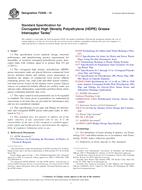Potřebujeme váš souhlas k využití jednotlivých dat, aby se vám mimo jiné mohly ukazovat informace týkající se vašich zájmů. Souhlas udělíte kliknutím na tlačítko „OK“.
ASTM G203-10
Standard Guide for Determining Friction Energy Dissipation in Reciprocating Tribosystems
Automaticky přeložený název:
Standardní Průvodce pro stanovení tření Energy odvodu v pístových Tribosystems
NORMA vydána dne 1.4.2010
Informace o normě:
Označení normy: ASTM G203-10
Poznámka: NEPLATNÁ
Datum vydání normy: 1.4.2010
Kód zboží: NS-57598
Počet stran: 8
Přibližná hmotnost: 24 g (0.05 liber)
Země: Americká technická norma
Kategorie: Technické normy ASTM
Kategorie - podobné normy:
Anotace textu normy ASTM G203-10 :
Keywords:
friction, friction coefficient, friction energy, ICS Number Code 21.260 (Lubrication systems)
Doplňující informace
| Significance and Use | ||||||||
|
Many sliding systems exhibit intermittent high friction force excursions compared to competing tribosystems. However, where friction forces or friction coefficients are averaged, the test data may show that the two systems have the same friction characteristics, when in fact they were not the same; there was a friction “problem” in the one with the periodic aberrations. The FED takes into account all friction forces that occur in the test increment. It is all of the friction energy that the couple dissipated in the designated test duration. It captures the friction profile of a system in a single number that can be used to screen candidate couples for friction characteristics. If the friction energy used in a reciprocating tribosystem is of concern this metric along with the friction recording, average coefficient of friction, and standard deviation of the force readings, produces the most meaningful data. It is a metric of the energy loss in a tribosystem. |
||||||||
| 1. Scope | ||||||||
|
1.1 This guide covers and is intended for use in interpreting the friction forces recorded in reciprocating tribosystems. The guide applies to any reciprocating tribosystem, whether it is a wear or fretting test or an actual machine or device. 1.2 The energy dissipation guide was developed in analyzing friction results in the Test Method G133 reciprocating ball-on-flat test, but it applies to other ASTM or ISO reciprocating tests. This technique is frequently used to record the friction response in fretting tribosystems. 1.3 Specimen material may play some role in the results if the materials under test display viscoelastic behavior. This guide as written is for metals, plastics, and ceramics that do not display viscoelastic behavior. It also applies to lubricated and non-lubricated contacts. 1.4 The values stated in SI units are to be regarded as standard. No other units of measurement are included in this standard. 1.5 This standard does not purport to address all of the safety concerns, if any, associated with its use. It is the responsibility of the user of this standard to establish appropriate safety and health practices and determine the applicability of regulatory limitations prior to use. |
||||||||
| 2. Referenced Documents | ||||||||
|
Podobné normy:
Historická
1.12.2010
Historická
1.4.2013
Historická
1.4.2013
Historická
1.5.2013
Historická
1.9.2014
Historická
1.4.2010
Doporučujeme:
Aktualizace technických norem
Chcete mít jistotu, že používáte pouze platné technické normy?
Nabízíme Vám řešení, které Vám zajistí měsíční přehled o aktuálnosti norem, které používáte.
Chcete vědět více informací? Podívejte se na tuto stránku.



 ASTM E2793-10e1
ASTM E2793-10e1 ASTM F1413-07(2013)..
ASTM F1413-07(2013).. ASTM F1460-07(2013)..
ASTM F1460-07(2013).. ASTM F1567-94(2013)..
ASTM F1567-94(2013).. ASTM F2649-14
ASTM F2649-14 ASTM G204-10
ASTM G204-10
 Cookies
Cookies
